

Bangladesh's Factories Are Safer and Greener Since Rana Plaza. But Are They Ethical? — Elizabeth L. Cline. This week marks the seventh anniversary of Rana Plaza, a 2013 factory collapse in Bangladesh that killed and injured thousands of garment workers and awakened a global movement to reform the fashion industry.
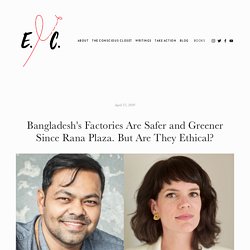
Seven years is a lot of time to make change. That’s a stretch of history that should yield serious transformation, especially considering how many companies and consumers claim to care about the ethics and sustainability of what they wear. Why donating your clothes isn’t as helpful as you think. Does Use Matter? Comparison of Environmental Impacts of Clothing Based on Fiber Type. Survey: Consumer sentiment on sustainability in fashion. Fashion on climate. Special Report Fashion on climate: How the fashion industry can urgently act to reduce its greenhouse-gas emissions As the need to address climate change becomes more urgent, industry sectors are working to reduce their carbon emissions.
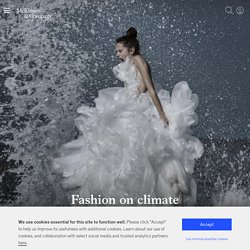
Fashion makes a sizeable contribution to climate change. McKinsey research shows that the sector was responsible for some 2.1 billion metric tons of greenhouse-gas (GHG) emissions in 2018, about 4 percent of the global total. Style that’s sustainable: A new fast-fashion formula. The early 21st century has been good to the apparel industry.
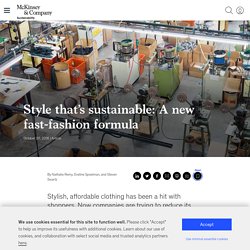
Thanks to falling costs, streamlined operations, and rising consumer spending, clothing production doubled from 2000 to 2014, and the number of garments purchased per capita between 2000 and 2014 increased by about 60 percent. Fast fashion has been a particularly hot segment and a source of enviable growth for some clothing companies. Bernardes 2018 IOP Conf. Ser.%3A Mater. Sci. Eng. 459 012090. Main. Birmingham City University - Sign In. How to make your kids' wardrobes more sustainable. Consumer Perceptions Related to Clothing Repair and Community Mending Events: A Circular Economy Perspective.
1.

Introduction The U.S. Environmental Protection Agency (USEPA) [1] estimates that post-consumer textile waste (PCTW) constitutes to almost 6% of the municipal solid waste in the U.S. landfills every year. PCTW has increased by almost 50% in the last 25 years, with 11.1 million tons (85%) of clothing ending up in the U.S. landfills in 2015 alone. Contrary to the belief that all donated clothes are resold/reused in the U.S., only about one-fifth of the clothing donated to charities is directly used or sold in thrift shops or exported to developing countries in Africa. Recognizing the global fashion industry’s impact on climate change, the United Nations Framework Convention on Climate Change (UNFCCC), in collaboration with different sectors and members across the global fashion supply chain, formed the Fashion Industry Charter on Climate Change (FICCC) in September 2018.
Drapers' Den: which are the best sustainability innovations? Five businesses with ideas spanning extending the life of cotton to building a marketplace of sustainable factories explained their innovations to attendees and a Dragons’ Den-style panel at Drapers’ sustainability conference.
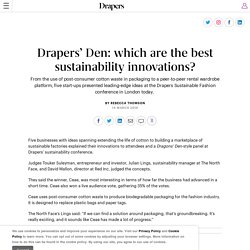
Judges Touker Suleyman, entrepreneur and investor, Julian Lings, sustainability manager at The North Face, and David Mallon, director at Red Inc, judged the concepts. They said the winner, Ceae, was most interesting in terms of how far the business had advanced in a short time. Ceae also won a live audience vote, gathering 35% of the votes. Ceae uses post-consumer cotton waste to produce biodegradable packaging for the fashion industry.
It is designed to replace plastic bags and paper tags. Birmingham City University - Sign In. Birmingham City University - Sign In. The Growing Potential Of The Resale Market, Fueled In Part By ThredUp. The resale market has expanded rapidly, in no small part because ThredUp’s vast offerings have been accepted for sale by a wide variety of major store chains like Walmart , Macy’s , JCPenney , Nordstro m and Gap , as well as Banana Republic, Athleta, Neiman Marcus, Hollister and many more.

Most of the sales are online, albeit Macy’s also sells ThredUp merchandise in 40 stores and Nordstrom has a selection in their New York flagship store available when that store reopens. I studied the potential of reselling worn clothes. Subscribe to read. Does fast fashion have to die for the environment to live? Fast-fashion retailers became giants by quickly churning out fresh, low-priced styles that pull trend-seekers into stores.
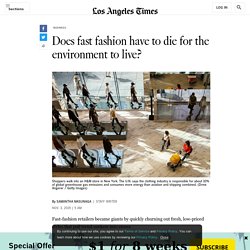
But that comes at a price. Rapidly producing clothes in large batches can save money, but if the items don’t all sell, that creates waste. Fast Fashion Avoidance Beliefs and Anti-Consumption Behaviors: The Cases of Korea and Spain. The term “fast fashion” refers to low-price clothes that move from the catwalk to a mass market by replicating current luxury fashion trends [1].
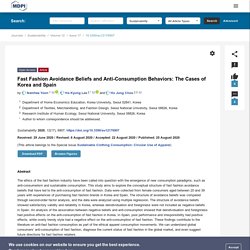
Newbie- sustainable kids brands. The Rise of Hand-Me-Down Inc. Mintel Portal. Burberry’s Sustainability Bond Raises Issues About Fashion’s Relationship With Chinese Cotton. White Paper - The Value Shift — Gain Trust 2. Rethinking the catwalk could slow down fast fashion. It became pretty clear early this year that the COVID-19 pandemic would wreck the haute couture fashion calendar for at least the coming season.

As the disease outbreak strangled the supply chain, cut off travel plans and scattered gatherings, designers' plans for various fashion weeks worldwide were thwarted. A ‘Natural’ Rise in Sustainability Around the World – Nielsen. When it comes to purchase behavior, it’s become abundantly clear that consumers care.

In fact, the majority (73%) of global consumers say they would definitely or probably change their consumption habits to reduce their impact on the environment. As consumers become increasingly aware of what they put in and on their bodies, they’re also interested in buying—and sometimes paying more—for products that simultaneously help the environment. In fact, almost half (41%) of consumers from around the world say that they’re highly willing to pay more for products that contain all-natural or organic ingredients. According to our Consumers Buy The Change They Wish To See in The World report, we found that natural and organic ingredients and certifications serve as the entry level point for nearly every market when it comes to sustainability attributes consumers are searching for.
Sustainable Development of Slow Fashion Businesses: Customer Value Approach. 1. Introduction With the increasing attention on sustainability within consumer culture, fast production movements are criticized for undermining sustainability, and therefore the slow trend has emerged in various areas such as slow food and slow life [1,2]. Why Aren't Consumers Willing to Pay More for Climate-Friendly Products? Shoppers once selected products based simply on price or brand, but now attributes such as “climate-friendly,” “green” and “eco-friendly” are part of the consideration.
The latest IAG New Zealand Ipsos poll found almost four out of five people (79 percent) say climate change is an important issue for them, the same number as last year’s poll. At the same time, an international study of 20,000 customers by multi-national consumer goods giant Unilever identified one in three (33 percent) people were choosing to buy from brands they believe are doing environmental good. Despite prevailing attitudes of consumers to prioritize sustainability and environmental good, research continues to show that few consumers who report positive attitudes toward eco-friendly products actually follow through with their wallets, which may help to explain the enduring demand for fast fashion and other mass-market goods.
Green, eco-friendly, climate-friendly products — confused? FASHION TRANSPARENCY INDEX 2020. The average score for all 250 brands and retailers is 23% out of 250 possible points, showing that the world’s biggest brands have a long way to go towards transparency.